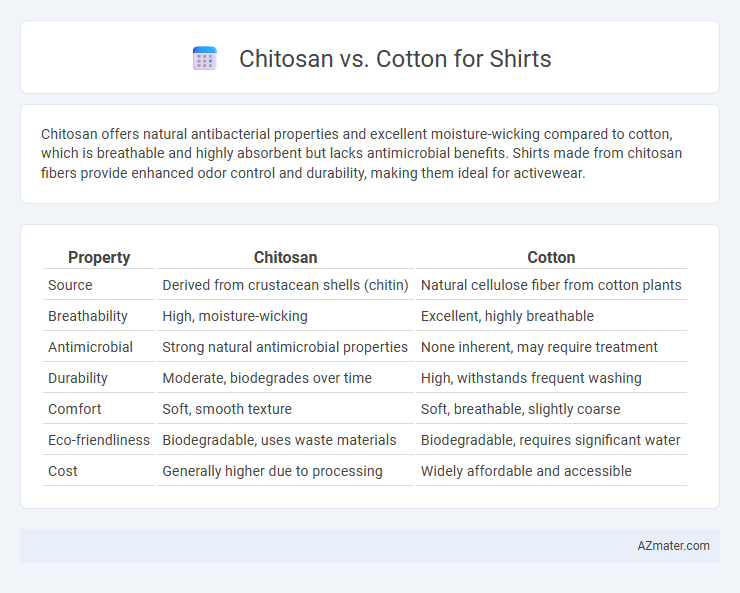Chitosan offers natural antibacterial properties and excellent moisture-wicking compared to cotton, which is breathable and highly absorbent but lacks antimicrobial benefits. Shirts made from chitosan fibers provide enhanced odor control and durability, making them ideal for activewear.
Table of Comparison
| Property | Chitosan | Cotton |
|---|---|---|
| Source | Derived from crustacean shells (chitin) | Natural cellulose fiber from cotton plants |
| Breathability | High, moisture-wicking | Excellent, highly breathable |
| Antimicrobial | Strong natural antimicrobial properties | None inherent, may require treatment |
| Durability | Moderate, biodegrades over time | High, withstands frequent washing |
| Comfort | Soft, smooth texture | Soft, breathable, slightly coarse |
| Eco-friendliness | Biodegradable, uses waste materials | Biodegradable, requires significant water |
| Cost | Generally higher due to processing | Widely affordable and accessible |
Introduction to Chitosan and Cotton Fabrics
Chitosan fabric, derived from chitin found in crustacean shells, offers natural antibacterial, biodegradable, and moisture-wicking properties, making it an innovative alternative to traditional textiles. Cotton fabric, a widely used natural fiber harvested from the cotton plant, is renowned for its softness, breathability, and durability in clothing applications. The unique biochemical structure of chitosan provides enhanced odor control and hypoallergenic benefits, while cotton remains valued for comfort and ease of maintenance in everyday shirts.
Origins and Production Processes
Chitosan, derived from the shells of crustaceans like shrimp and crabs, undergoes a chemical extraction process involving deacetylation of chitin to produce its fiber form, while cotton originates from the fluffy fibers surrounding the seeds of the cotton plant and is harvested through mechanical or hand-picking methods followed by ginning and spinning. The production of chitosan shirts emphasizes sustainability by utilizing marine waste, whereas cotton cultivation requires significant water, pesticides, and labor-intensive farming practices. These fundamental differences in origin and production impact the environmental footprint and material properties of chitosan versus cotton shirts.
Environmental Impact Comparison
Chitosan fabric, derived from crustacean shells, is biodegradable and promotes waste utilization, reducing landfill accumulation compared to conventional cotton, which requires extensive water, pesticide use, and land resources for cultivation. Cotton production's high environmental footprint includes significant water consumption--approximately 10,000 liters per kilogram of fiber--and chemical fertilizers that contribute to soil degradation and water pollution. In contrast, chitosan's byproduct sourcing and inherent antimicrobial properties support sustainable textile manufacturing with lower ecological strain and waste generation.
Breathability and Comfort Levels
Chitosan fabric offers superior breathability compared to cotton due to its micro-porous structure that enhances air circulation and moisture management. Cotton, while naturally soft and comfortable, tends to retain moisture, which can reduce overall comfort during extended wear. The antimicrobial properties of chitosan also contribute to improved comfort by minimizing odor and skin irritation, making it an ideal choice for active or sensitive skin.
Durability and Longevity
Chitosan fabrics exhibit superior durability compared to cotton due to their enhanced antibacterial properties and resistance to wear and tear, resulting in longer-lasting shirts. Cotton shirts tend to weaken and fade faster with frequent washing, while chitosan-treated textiles maintain structural integrity and color retention over extended use. The natural resilience and bioactive characteristics of chitosan fibers ensure increased longevity, making them a more sustainable choice for durable apparel.
Skin-friendliness and Allergenicity
Chitosan shirts exhibit superior skin-friendliness due to their natural antimicrobial properties and excellent moisture absorption, reducing skin irritation and promoting comfort for sensitive skin. In contrast, cotton is widely known for its breathability and softness but may retain allergens like dust mites, potentially triggering allergic reactions in sensitive individuals. Chitosan's hypoallergenic nature combined with cotton's softness makes chitosan blends an optimal choice for minimizing allergenicity while ensuring gentle wear against the skin.
Moisture Management Capabilities
Chitosan fibers exhibit superior moisture management capabilities compared to traditional cotton, effectively absorbing and releasing sweat to keep the skin dry and comfortable. The hydrophilic nature of chitosan enhances breathability and accelerates moisture evaporation, reducing the risk of bacterial growth and odors. Cotton, while naturally absorbent, tends to retain moisture longer, which can lead to dampness and discomfort during prolonged wear.
Biodegradability and Sustainability
Chitosan-based fabrics exhibit superior biodegradability compared to traditional cotton, breaking down more rapidly in natural environments and reducing landfill accumulation. The production of chitosan fibers utilizes renewable marine byproducts, offering a sustainable alternative to the water-intensive and pesticide-reliant cultivation of cotton. Leveraging chitosan for shirts enhances eco-friendly textile solutions by minimizing environmental impact through efficient waste recycling and lower resource consumption.
Cost and Market Availability
Chitosan-based shirts tend to be more expensive than cotton due to the complex extraction and processing methods involved, with average prices ranging from $30 to $70 per garment compared to $15 to $40 for cotton shirts. Market availability for cotton remains widespread and consistent globally, supported by a mature supply chain and large-scale farming, whereas chitosan shirts are primarily found in niche eco-friendly and specialty apparel markets with limited production volumes. The growing demand for sustainable textiles is increasing chitosan's market presence but it still lags behind cotton's dominant position in mass apparel retail.
Future Trends in Shirt Fabric Innovation
Chitosan fabric, derived from shrimp shell biopolymers, offers antimicrobial, biodegradable, and moisture-wicking properties that align with sustainability trends, contrasting with traditional cotton's high water usage and slower biodegradability. Innovations in bio-based fibers like chitosan are driving the future of shirt fabrics towards eco-friendly, performance-enhancing textiles. Emerging technologies in textile engineering prioritize combining natural fibers with chitosan to develop durable, odor-resistant, and skin-friendly shirts that meet consumer demand for sustainable fashion.

Infographic: Chitosan vs Cotton for Shirt
 azmater.com
azmater.com